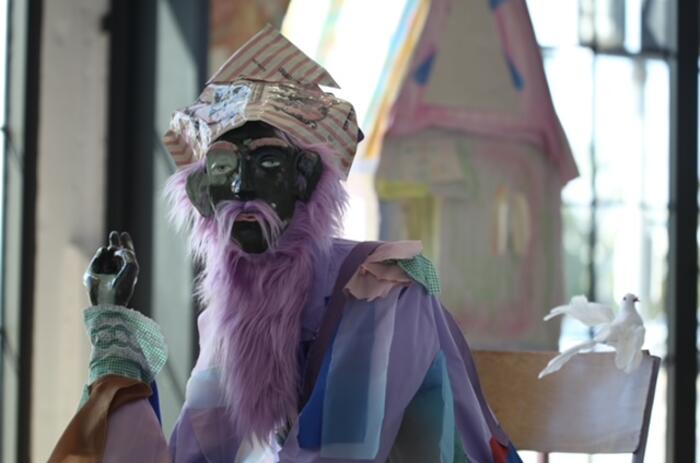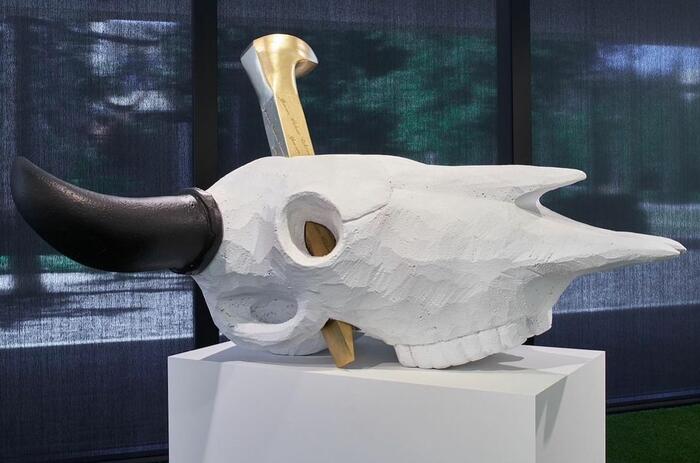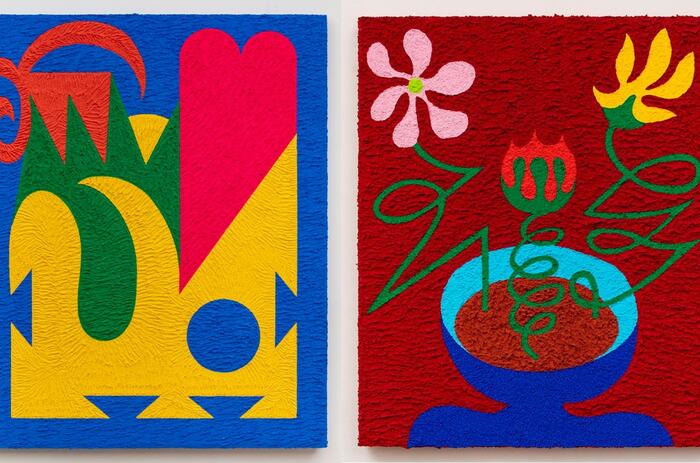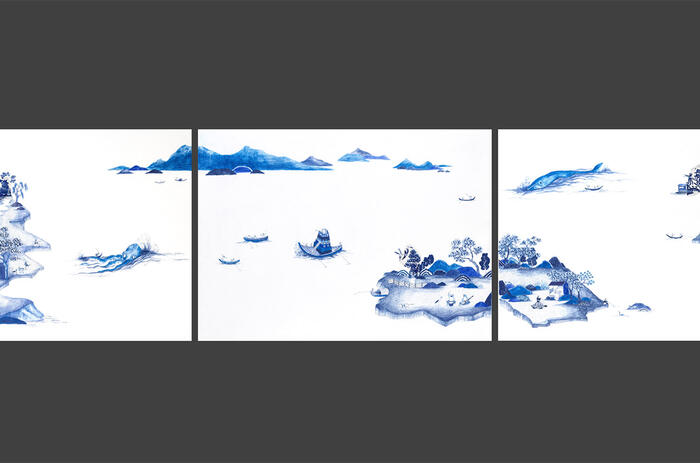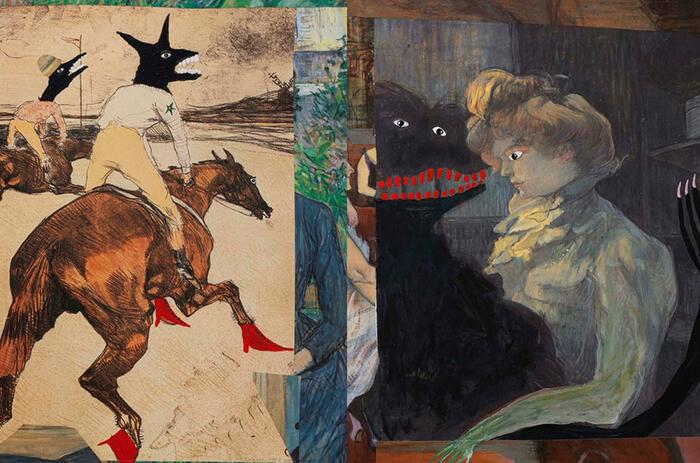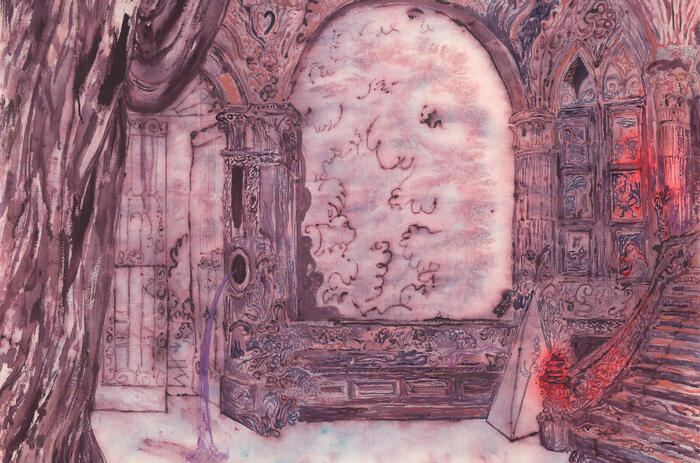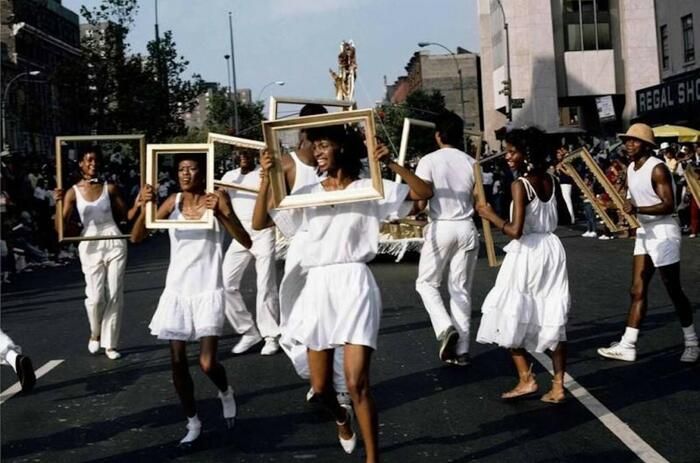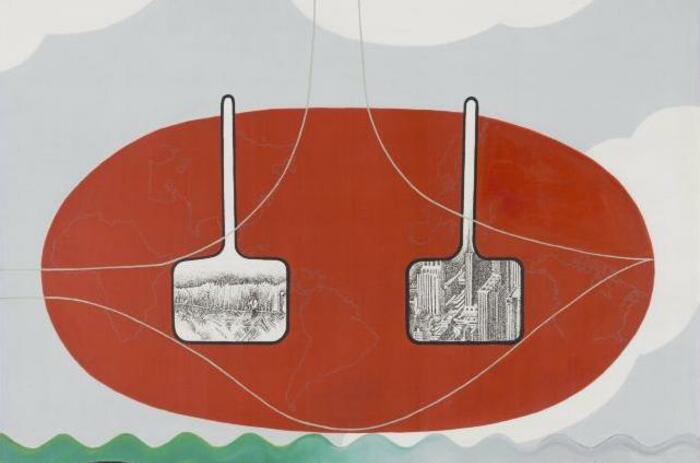CANVASES THAT SPEAK
The exhibition Claro que sí (Of course it is) by Mariana Ferrari (1975, Tucumán, Argentina) is on display at Tomás Redrado Art.
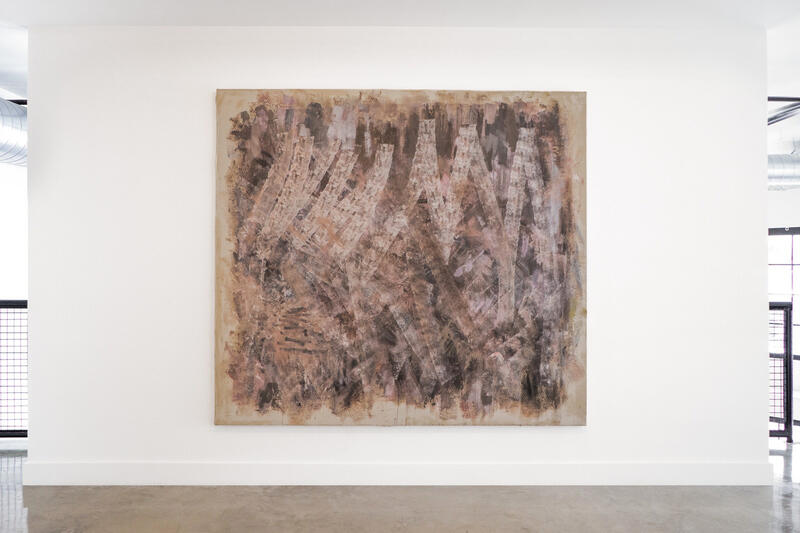
What remains and what does not. There are many photos of MF’s canvases: in the morning, hung over the living room wall of her home where the sun ray’s shine directly over the balcony onto the painting; in the afternoons on another wall, where the sun hits it indirectly; or even as the day goes by, and the light moves across the wooden floor where the canvas is spread. In some photos the spots of light are larger, while in others there are whole areas covered by shadows – a window tucked o to the side with partially lowered blinds, or fully raised, invaded by the presence of plants from when the image was taken in her studio. There are photos taken facing the canvases, others from the side; in some MF appears in front of them. In most of them you can see the frayed edges of the canvases, the walls on which they are supported, the floor, the openings of the rooms in which they are found, the plastic that protects the floors from paint stains, a ladder, a small table with materials on top, other works hung at a distance. Some photos have been taken very closely, and what can be seen is another canvas poorly glued on the canvas, both painted, or not, a crumpled piece of paper in the same situation, a piece of newsprint, on which you can almost read some paragraphs of what it says.
Quantum. “Most of the photos I take are of fragments. I choose a fragment knowing that it will not last. It’s like keeping an eye on a spot for a while knowing that the painting is going to change because I’m going to continue painting it. It is something that painting, in its transience, allows it to be incorporated into its own performativity”, says MF. The work as a non-specific object, as an interface, located in the imaginary space between the canvas and the photo. A new object of thought, neither painting nor photography, but what happens between the two. The photo is a predicate of experience, it restores its punctuality to the canvas. Take that performativity to its logical extreme. The work is at the moment and in the circumstance which it is photographed as. MF’s canvases, when they are not seen, are not, but every time they are seen, they are different.
Parenthesis. (It is not the canvas but the images of the canvas that we see in the photos of MF’s work. The photo makes sculptures out of each piece, spatializing them. It is the situation itself that the photo registers, that signals the presence of the volume, fixing the multiplication of the points of view it generates).
Ethics. What do we see in MF’s paintings? Opacity and nuances – the broken colors of northern landscapes, rococo carnations, studies of body temperature, and the temperature of carnations. The palette comes from the pink of bodies. Heights that compromise the body. Meat and skin. Dulled colors, more like the color of the wall than to the knob on a door. Paintings of action – not clichés. Half mural and half cave. Images without stretchers or rollers, arms that paint. Handprints, traces of action. The physical gesture of doing meaningless things. Eroticism defeating iconography. A material forced by an exhausted bod and the performance of that body. Things that are put in tension. Changing states. Testimony. Feeling and tension. Multiplicity and simultaneity. Between armation and denial, an ethic: intermediate places not defining, other options.
Phrase. The circumstances that make possible what is seen.
Hypothesis and entropy. But the paintings also say many other things. There is a sound in MF’s canvases, a sound that cannot be heard. It is a sound that must be taken from the gesticulation in her paintings. MF’s works gesticulate, as if they were speaking, as if many voices were speaking at the same time. As if someone had danced while listening to her movements. Her paintings say so many things that they seem on the verge of schizophrenia, the background noise of our civilization. MF’s paintings border on the disorder of statements because of their discursive framework.
Approaching a formulation and leaving it behind. Reaching for a formulation and leaving it behind. The artists work on extracting the text that is in their work, while pretending that their work does not have text; freeing the work of the text seems to be the sine qua non of contemporaneity. It is its utopian condition, to the extent that it does not seem possible but is imaginable: a world where all texts would have ceased. Something like the release of all releases. However, at the same time that they work on the extraction of the text of their works, they do so on the demand for the production of texts about their work. As if, without a textual correlation, the work of annulment of the text could not develop.
Ceaseless Grammar. The canvases have been occupying one of the most uncomfortable spaces. We no longer see in them what we saw before, although they remain the same. We no longer know exactly what we have to see when we look it: where to fix our gaze, how to detect a presence, a figure, what to call upon that figure, how to slide our gaze over it, when to recognize something, if it is what to recognize still has value, or where to find value if recognition is impossible. How to look from one figure to the other, how to identify the parts, and then assemble them to find a kind of grammar. Grammar is the narrative of the image. It is not possible to think of an image without a story. Even the void seems to be structured.
Either/Or? Once upon a time there was a dynamic, a historical, material dynamic that seemed to guide us. Today that same material history has ended up losing the guide of that dynamic. The rhythms have changed, or they have entered an entropic state. We no longer see what was seen, but neither do we know how to look. And if that historical dynamic had been that of the loss of that grammar, that of its destruction – then today, would that grammar have ceased to exist? Is it possible there isn’t one anymore? Again: like utopia, almost hellish. Or is there always a living grammar?
Drowned in meaning. While contemporary art advances in meaning until it almost manifests a willingness to want to be drowned by it, canvases, on the other hand, recede. Contemporary art advances towards images, while canvases recede from them. Without having changed materially, nor in the field of representation, unexpectedly, without anything happening to the object, while apparently doing nothing but aging, the canvases have become detached from their perceptual system, and now it seems to be rebuilding itself, reformulating itself all the time.
Entropy II. The frame of MF’s art is invisible, but it still exerts a pressure that keeps the canvas in tension. An art without a frame would be entropic art. In MF’s work, the entropic is confused with the explosive. It is the pressure of the invisible frame that tenses the proximities, the distances, in her canvases. There is a synthesis, a point at which the entropic and the explosive, which seem to be diametrically opposed, overlap, and that synthesis is in its transformation. MF’s frames are moments of a transformation.
Another parenthesis. (The invisible frame, that which can be deduced from the eects it produces on others, is what looks at us. We cannot see it, we can never see it. For that we would have to get out of ourselves and transform. But by becoming other we would also lose ourselves. No one can become another and return. To leave is not to be seen. The one who returns is always the same. The other is the invisible frame. If it were visible, it would cease to be another, it would probably cease to be a frame. It would be a threshold. It seems to be there, in that inaccessible, impossible interiority, where the last grain of text takes refuge from the violence of transformation. It is in the impossibility of the invisible that MF’s art treasures the smallest grain of its textuality).
Shamanism. Gestures are always gestures of a dramaturgy. The dramaturgy may be there, but it may also have been there. It is not possible to imagine a gesture without the drama that signifies it, but it is possible to face gestures whose drama is dicult for us to reconstitute. Linguists would say that a gesture without meaning is unthinkable. If it doesn’t mean, it’s not a gesture. Someone says that under the paint and the materials that cover the MF’s canvases there are other paints that have been covered. There are images painted with brushes that have been covered by oil or cement spread by hand, with rollers. There are also those who say that what is under the paint that covers the MF canvases is more paint, but no longer painted with a brush; no longer figures, no images, but gestures, perhaps similar to those that cover them. But MF’s canvases could also be telling us something else: telling us that the gesture comes first, and that the dramaturgy comes later. In that case, the question would be: who is gesturing? Who tells the drama on the MF canvases? And what drama is represented by the gestures that cover MF’s canvases? Where should one start? Writing is changing the beginnings. The transformations in MF’s canvases are violent. They are transformations of the canvas’ very fabric. They disassemble the bodies, dismember them, crush them, expel the remains of the mutilations with centrifugal force. They are images that have exploded from within. Images do not resist transformations, unless they become the image of the transformation. The force of the transformations is too much not to destroy any attempt to raise the outline of an image even very precariously. The time of the topics ended. A useless machinery remains, gesturing in a fragmentary, intermittent manner. That is art, MF’s fabrics speak to us.
We eloped. What we look at in MF’s canvases, if you will, are the circumstances of the existence of that work, the circumstances of the existence of the possibility of signification. They are all circumstances, because it goes backwards, and each one of them seems to be divided into others. A dance of circumstances, it would be, more as if they did not stop disorganizing than organizing. It does not constitute the significant space ahead, but in the opposite sense: it is a new space that is generated by subdivision where the possibility of signification occurs. A leak. The further the meaning recedes from the circumstances that make it possible, the more opaque the picture becomes.
…? It is a decision of the artist, of people, of life, how not to come to constitute a text. It is a sentence instead of a text. It’s a twist on the logic of a sentence. How to arrive at not constituting a text implies, on the other hand, a goal achieved. There is no text, but there is no twist either. The path is continuous, linear. It consolidates. It’s not about quantifying. It is always a question of a comma, of an articulation. Without torsion of a logic there is no change either. Probably the change in the transformation of MF’s work is inscribed in that invisible frame that is never mentioned, which even makes us pretend it doesn’t exist. It is about “not arriving”, and not “arriving at not”. In order not to reach something, you have to avoid certain routes, rather than hit others. Is it then, eFectively, fleeing? Flee from where, in that case? What would happen if instead of not going we came back? Is not the return registered in the journey? Not arriving is also deleting the registration of a return. Nothing is predictable or determined in the canvases of MF. Writing is invented in each stroke, and in each stroke it is erased.
Botany. The Uruguayan narrator Felisberto Hernández writes in “Explanación Falsa de Mis Cuentos”, a text that works as an introduction to his book Las Hortensias, by xxxx: “At a given moment I think that a plant will grow in a corner of me. I start stalking her, believing that something strange has happened in that corner, but that it could have an artistic future. I would be happy if this idea would not fail at all. However, I must wait an unknown span of time: I do not know how to make the plant germinate, nor how to favor or take care of its growth; I only intuit or wish that it has pages of poetry, or that something becomes poetry if certain eyes look at it. I must take care that it does not take up too much space, that it does not pretend to be beautiful or intense, but that it is the plant that it itself is destined to be, and help it to be. She herself will know its laws, although she has them deep inside her so that her conscience cannot not reach them.
CLARO QUE SÍ. Exhibition by Mariana Ferrari.
Through May 27, 2023.
Tomás Redrado Art. Little River, Miami.

